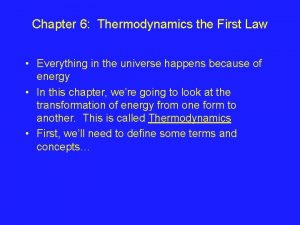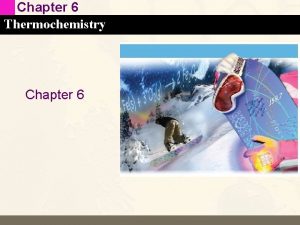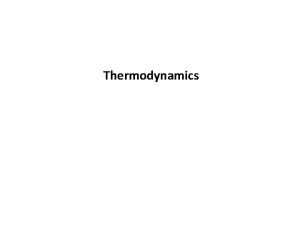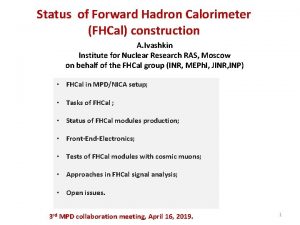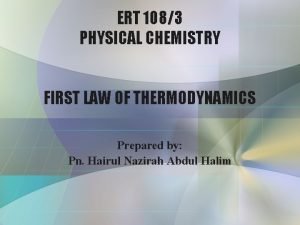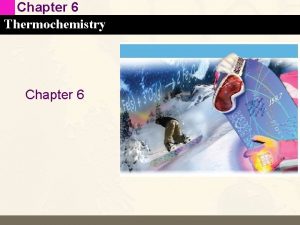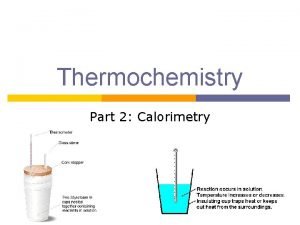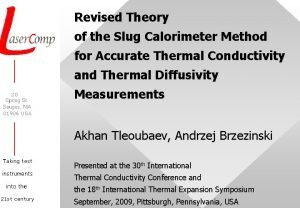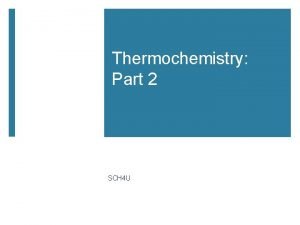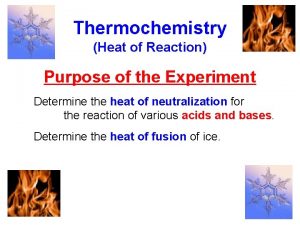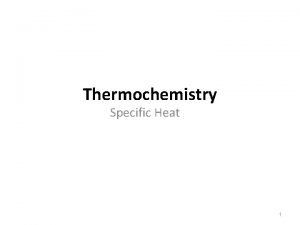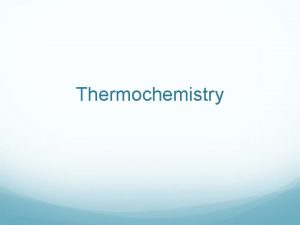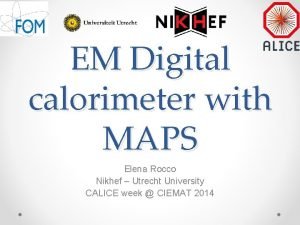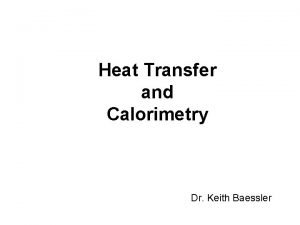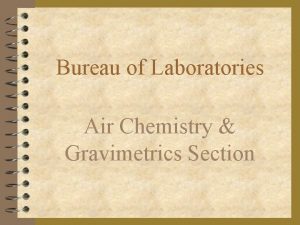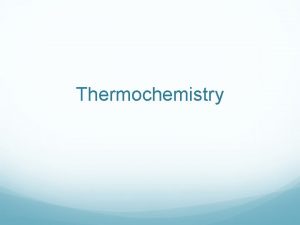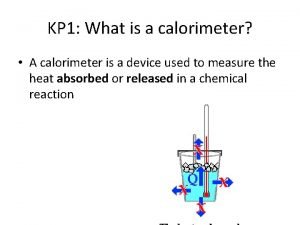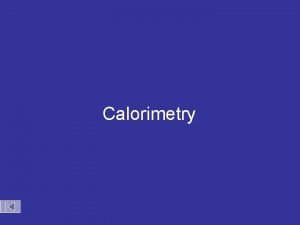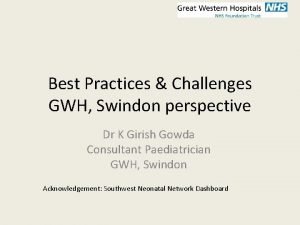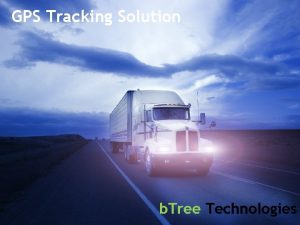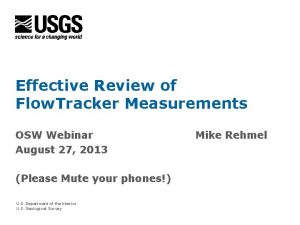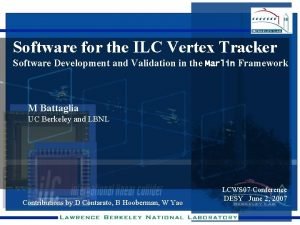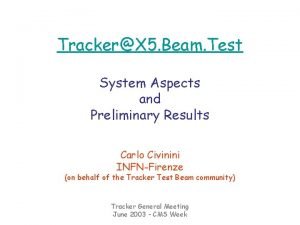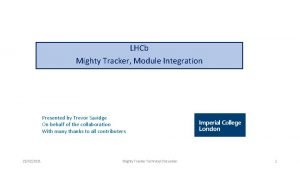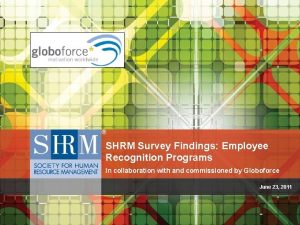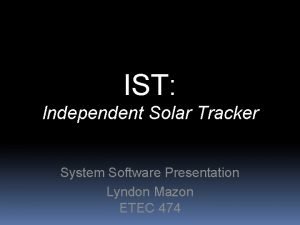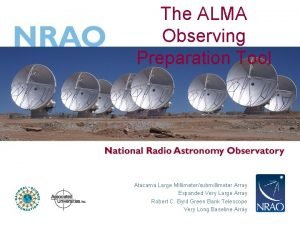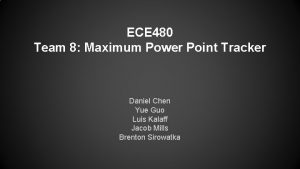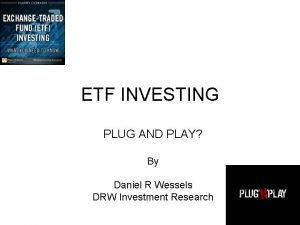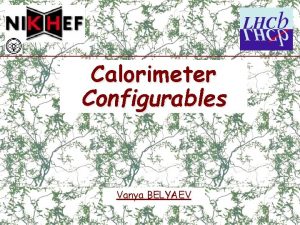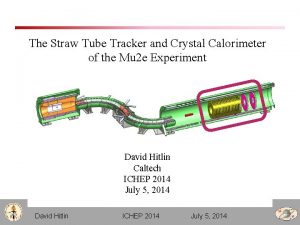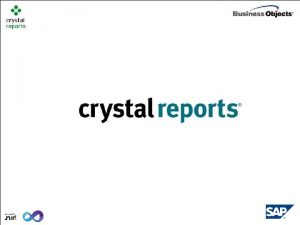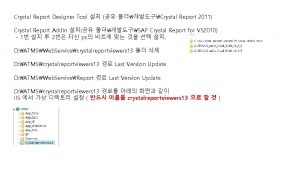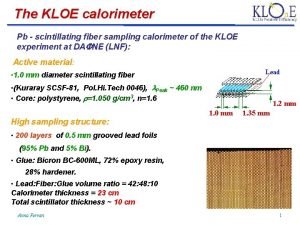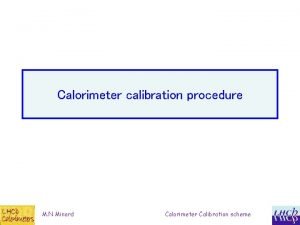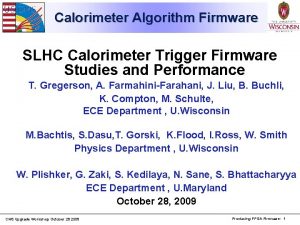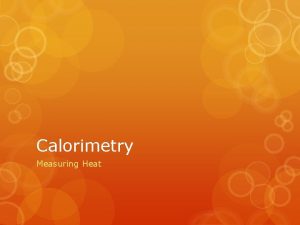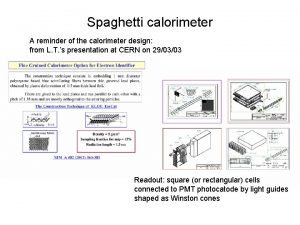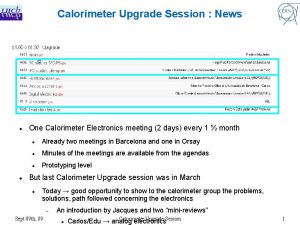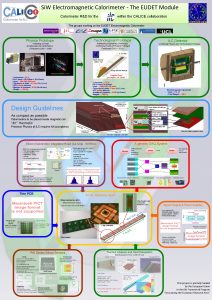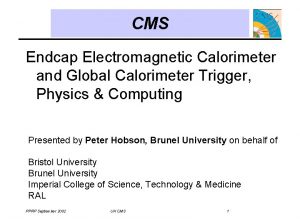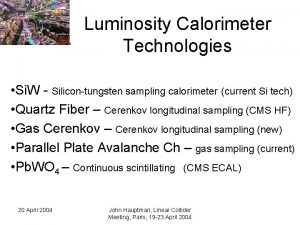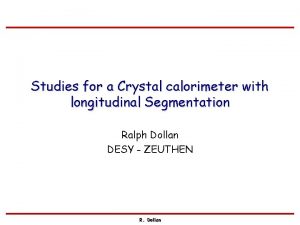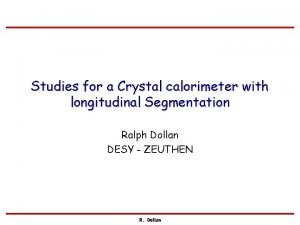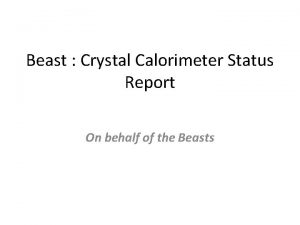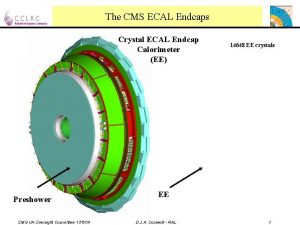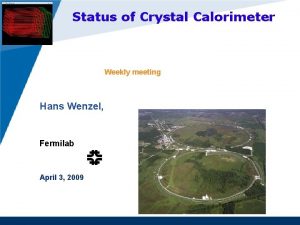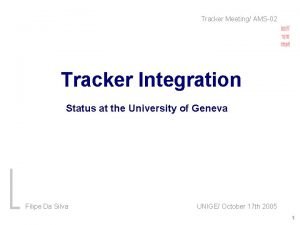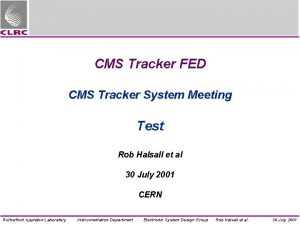z EM Calorimeter y Crystal z Tracker y
























































- Slides: 56













Γεωμετρια ενος ανιχνευτη z EM Calorimeter y. Crystal z Tracker y. Precision y. Drift Chamber BABAR (SLAC, US) 27 Ιουνιου 2008 Ι. Αποστολακης 13









Ιεραρχεια Δεδομενων (Data) ~2 MB/event ~100 k. B/event ~1 k. B/event 27 Ιουνιου 2008 March 13 RAW Οτι κατεγραψαν οι ανιχνευτες (DAQ) Detector digitisation 109 events/yr * 2 MB =2 PB/yr ESD Ανασυγκροτηθησα πληροφορια Pattern recognition information: Clusters, track candidates AOD Συμπερασματα για την αναλυση Physical information: Transverse momentum, Association of particles, jets, (best) id of particles, TAG Classification information Relevant information for fast event selection Ι. ΑποστολακηςGGF 10 / PNPA – RG Workshop – J 22





Wide Area Network T 2 T 2 Tier-2 s and Tier-1 s are inter-connected by the general purpose research networks T 2 T 2 Grid. Ka IN 2 P 3 T 2 Any Tier-2 may. Brookhaven access data at any Tier-1 Nordic TRIUMF Dedicated 10 Gbit optical network ASCC T 2 Fermilab T 2 RAL CNAF PIC SARA T 2 T 2 T 2 LCG

LCG § § § Grid Activity Continuing increase in usage of the EGEE and OSG grids All sites reporting accounting data (CERN, Tier-1, -2, -3) Increase in past 17 months – 5 X number of jobs - 3. 5 X cpu usage 100 K jobs/day 23 -Oct-07 28 les. robertson@cern. ch


LCG September 2007 - CPU Usage CERN, Tier-1 s, Tier-2 s § last update 12/06/2021 > 80% of CPU Usage is external to CERN

LCG Backup

LCG depends on two major science grid infrastructures …. EGEE OSG last update 12/06/2021 - Enabling Grids for E-Science - US Open Science Grid

LCG § The Worldwide LHC Computing Grid The LHC physics data analysis service distributed across the world § CERN, 11 large Tier-1 centres, ~ 140 active Tier-2 centres § Status in May 2007 § Established the 10 Gigabit/sec optical network that interlinks CERN and the Tier-1 centres § Demonstrated data distribution from CERN to the Tier-1 centres at 1. 3 GByte/sec – the rate that will be needed in 2008 § ATLAS and CMS can each transfer 1 Peta. Byte of data per month between their computing centres § Running ~2 million jobs each month across the grid § The distributed grid operation, set up during 2005, has reached maturity, with responsibility shared across 7 sites in Europe, the US and Asia § End-user analysis tools enabling “real physicists” to profit from this worldwide data-intensive computing environment last update 12/06/2021

LCG last update 12/06/2021 Data Organisation Ι. ΑποστολακηςGGF 10 / PNPA – 27 Ιουνιου 2008 March 13 2004 34

Backup More on simulation

Geant 4 geometry: what it does Describes a Detector z Hierarchy of volumes z Many volumes repeat y Volume & sub-tree z Up to millions of volumes for LHC era z Import detectors from CAD systems Navigates in Detector z Locates a point z Computes a step y Linear intersection 27 Ιουνιου 2008 Ι. Αποστολακης 36

Propagating in a field Charged particles follow paths that approximate their curved trajectories in an electromagnetic field. z. It is possible to tailor ythe accuracy of the splitting of the curve into linear segments, ythe accuracy in intersecting each volume boundaries. z. These can be set now to different values for a single volume or for a hierarchy. 27 Ιουνιου 2008 Ι. Αποστολακης 37

Electromagnetic physics z Gammas: y Gamma-conversion, Compton scattering, Photo-electric effect z Leptons(e, m), charged hadrons, ions y Energy loss (Ionisation, Bremstrahlung) or PAI model energy loss, Multiple scattering, Transition radiation, Synchrotron radiation, z Photons: y Cerenkov, Rayleigh, Reflection, Refraction, Absorption, Scintillation z High energy muons and lepton-hadron interactions z Alternative implementation (“low energy”) yfor applications that need to go below 1 Ke. V 27 Ιουνιου 2008 Ι. Αποστολακης 38

Antiproton annihilation - CHIPS Model neutron π K triton deuteron He-4 27 Ιουνιου 2008 He-3 Ι. Αποστολακης proton M. Kossov 40

Simulation ‘packages’ z Provides the means to simulate ythe physical processes and ydetector response of an experiment. z As was realised by many in the past, ymost of the parts needed can be common between experiments (eg physics, geometry blocks). z So it makes eminent sense to create and use a general purpose package y. That includes the common parts, y. And enables an experiment to describe those parts with are specific to it. 27 Ιουνιου 2008 Ι. Αποστολακης 41

Cosmic rays, jovian electrons X-Ray Surveys of Asteroids and Moons Solar X-rays, e, p Geant 3. 21 ITS 3. 0, EGS 4 Courtesy SOHO EIT Induced X-ray line emission: indicator of target composition (~100 mm surface layer) Geant 4 C, N, O line emissions included ESA Space Environment & Effects Analysis Section 27 Ιουνιου 2008 Ι. Αποστολακης 42

HEP Processing stages and datasets event filter (selection & reconstruction) detector processed data Event Summary Data (ESD) raw data event reconstruction batch physics analysis Analysis Object Data (AOD) (extracted by physics topic) event simulation individual physics analysis 27 Ιουνιου 2008 March 13 Ι. ΑποστολακηςGGF 10 / PNPA – RG Workshop – J 44

CERN Centre Capacity Requirements for all expts. (made July 2003) Other experiments LHC Moore’s law 27 Ιουνιου 2008 March 13 Ι. ΑποστολακηςGGF 10 / PNPA – RG Workshop – J 45

Event Data q Complex data models Ø ~500 structure types RAW ESD AOD versions Event Rec Phys Coord Tracks Cand Raw Velo Calo Collaboration Data 27 Ιουνιου 2008 March 13 AOD Event Phys My. Trk Private q References to describe relationships between event objects Ø unidirectional q Need to support transparent navigation q Need ultimate resolution on selected events Ø need to run specialised algorithms Ø work interactively q Not affordable if uncontrolled Ι. ΑποστολακηςGGF 10 / PNPA – RG Workshop – J 46

HEP Metadata - Event Collections Run Catalogue Physics : Run 21437 MC: B -> π π MC: B -> J/Ψ (μ+ μ-) … Collection Catalogue B -> ππ Candidates (Phy) B -> J/Ψ (μ+ μ-) Candidates … Bookkeeping 27 Ιουνιου 2008 March 13 Run Run Data Event 1 Event 2 … … 3 Event N Dataset Event tag Event 1 collection Event 2 … Tag 1 5 …Tag 2 2 Event 3 Event … 3 Tag M 8 Ι. ΑποστολακηςGGF 10 / PNPA – RG Workshop – J 0. 3 1. 2 3. 1 47

Detector Conditions Data q Reflects changes in state of the detector with time q Event Data cannot be reconstructed or analyzed without it q Versioning q Tagging q Ability to extract slices of data required to run with job q Long life-time Version Time VDET alignment HCAL calibration RICH pressure ECAL temperature t 1 t 2 Data Item Version t 3 t 4 t 5 t 6 t 7 t 8 t 9 t 10 t 11 Time = T Tag 1 definition Time 27 Ιουνιου 2008 March 13 Ι. ΑποστολακηςGGF 10 / PNPA – RG Workshop – J 48

A Multi-Tier Computing Model Tier 0 CERN (Experiment Host lab) Tier 2 5 15 ps mb Gb ps RAL regional group Lab a 15 5 Tier 3 mb ps Uni b Lab c Tier 3 Lab a IN 2 P 3 ps FNAL Mb (Main Regional Centres) ps Mb 2 62 Lab m Uni x 622 Tier 1 2. 5 Tier 1 ………. Italy Uni n Uni CERN Tier 1 UK USA France Desktop ………. Germany Lab b Uni y a Uni n Tier 2 Lab c physics group Uni b Desktop Manager View 27 Ιουνιου 2008 March 13 Ι. ΑποστολακηςGGF 10 / PNPA – RG Workshop – J User View 49

Distributed Analysis – the real challenge q Analysis will be performed with a mix of “official” experiment software and private user code Ø How can we make sure that the user code can execute and provide a correct result wherever it “lands”? q Input datasets not necessarily known a-priori q Possibly very sparse data access pattern when only a very few events match the query q Large number of people submitting jobs concurrently and in an uncoordinated fashion resulting into a chaotic workload q Wide range of user expertise q Need for interactivity - requirements on system response time rather than throughput q Ability to “suspend” an interactive session and resume it later, in a different location q Need a continuous dialogue between developers and users 27 Ιουνιου 2008 March 13 Ι. ΑποστολακηςGGF 10 / PNPA – RG Workshop – J 50

Visualization z Much functionality is implemented z Several drivers: y Open. GL, VRML, Open Inventor, Opacs, DAWN renderer (G 4) z Also choice of User Interfaces: y. Terminal (text) or y. GUI: Momo (G 4), OPACS y Editors for geometry, EM physics code generation 27 Ιουνιου 2008 Ι. Αποστολακης 51

One area: Tracking z. What a simulation code needs to do for each step of particle: y. Determine the step length x. Corresponding to the applicable physics processes x. Checking if it crosses a geometrical boundary y. Model the final state of the track, x. Advancing it, potentially in an EM field, x. Applying the actions of the physics processes, • which can create secondary particles. y. Deposit energy in current position (‘hit’). 27 Ιουνιου 2008 Ι. Αποστολακης 52

Actions during a Step z. During each step y. Each physics process is given the opportunity to limit the step, xas is the geometry module (at a boundary), and xleading to the decision on this step’s length. y. Physics processes are allowed to apply their effect x. If they occur along a step (‘continuous’) x. If they caused the ‘hard’ event that limited the step (‘discreet’). 27 Ιουνιου 2008 Ι. Αποστολακης 53

Actions during a Step (cont) z. During a step (continued) y. An (optional) user-written ‘action’ is called, x. Which can be used eg to create histograms or tallies. y. If the current volume contains a sensitive detector, that is addressed, allowing it eg xto record the energy deposited, xto record the exact position in general to create a ‘hit’ that store all information that is relevant for that detector. 27 Ιουνιου 2008 Ι. Αποστολακης 54

Actions during a Step (cont) z. During a step (continued) y. A parametrisation can be triggered (Geant 4) x. Taking over from ‘detailed’ simulation x. Generating directly several hits This application-specific operates instead of ‘normal’ physics processes until it returns control and/or resulting particles for further ‘detailed’ simulation. Step Begin of step point 27 Ιουνιου 2008 Ι. Αποστολακης End of step point Boundary 55

GEANT 4 z Detector simulation tool-kit for HEP yoffers alternatives, allows for tailoring z Software Engineering and OO technology yprovide the method for building, maintaining it. z Requirements from: y. LHC yheavy ions, CP violation, cosmic rays ymedical and space science applications z World-wide collaboration 27 Ιουνιου 2008 Ι. Αποστολακης 56


Multiple scattering model z A new model for multiple scattering based on the Lewis theory is implemented ysince public b release in 1998. z It randomizes momentum direction and displacement of a track. y. Step length, time of flight, and energy loss along the step are affected, and y. It does not constrain the step length. 27 Ιουνιου 2008 Ι. Αποστολακης 59
 Coffee cup calorimeter formula
Coffee cup calorimeter formula Coffee cup calorimeter vs bomb calorimeter
Coffee cup calorimeter vs bomb calorimeter Calorimeter problems
Calorimeter problems Constant volume calorimeter
Constant volume calorimeter Calorimeter formula
Calorimeter formula Hadron calorimeter
Hadron calorimeter Calorimeter
Calorimeter Unit of bmr
Unit of bmr Bomb calorimeter uses
Bomb calorimeter uses Coffee cup calorimeter equation
Coffee cup calorimeter equation Calorimetry questions
Calorimetry questions Slug calorimeter
Slug calorimeter The seven forms of energy
The seven forms of energy Accelerating rate calorimeter
Accelerating rate calorimeter 62g
62g Bomb calorimeter uses
Bomb calorimeter uses Homemade calorimeter
Homemade calorimeter Calorimeter
Calorimeter Elena rocco
Elena rocco Keith baessler
Keith baessler Coffee cup calorimeter
Coffee cup calorimeter Parr calorimeter
Parr calorimeter Calorimeter
Calorimeter How does a calorimeter work
How does a calorimeter work Constant volume calorimeter
Constant volume calorimeter Calorimeter
Calorimeter Timelog tracker
Timelog tracker Florida water tracker
Florida water tracker Training tracker gwh
Training tracker gwh Btree tracker
Btree tracker Subgroup: tracker
Subgroup: tracker Dsp research tracker
Dsp research tracker Folio tracker medicus
Folio tracker medicus Psctracker
Psctracker Flow tracker 2
Flow tracker 2 Act login army
Act login army Dsp research tracker
Dsp research tracker Napis pest tracker
Napis pest tracker Ndsu microsoft office
Ndsu microsoft office Tracker software physics
Tracker software physics Bentex tracker
Bentex tracker Dtn time tracker
Dtn time tracker Ardis login
Ardis login Ccea topic tracker
Ccea topic tracker Electronic prescription tracker
Electronic prescription tracker Mighty tracker
Mighty tracker Otis tracker
Otis tracker Employee recognition tracker
Employee recognition tracker Solar tracker software
Solar tracker software National student clearinghouse student tracker
National student clearinghouse student tracker Alma project tracker
Alma project tracker Ece tracker
Ece tracker Wholesale solar panel tracker
Wholesale solar panel tracker Hobbit tracker
Hobbit tracker Nsw premier 10 week challenge
Nsw premier 10 week challenge Tiny tracker aprs
Tiny tracker aprs Investor swix
Investor swix

